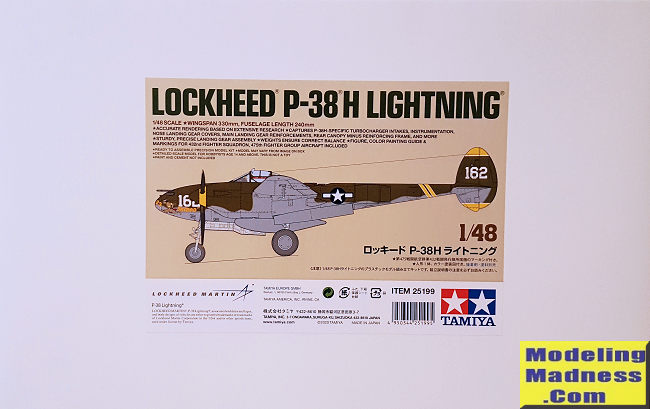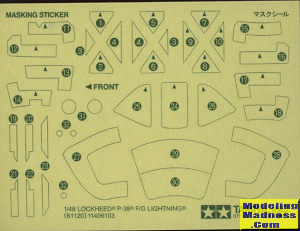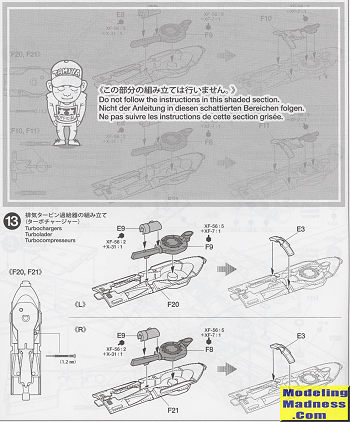
Tamiya 1/48 P-38H Lightning
| KIT #: | 25199 |
| PRICE: | 4680 yen. |
| DECALS: | One option |
| REVIEWER: | Scott Van Aken |
| NOTES: | 2020 release |

| HISTORY |
The P-38H was a stop-gap Lightning to keep the productio lines open in preparation for the P38J. 600 aircraft were built. These had an improved 20 mm cannon and a bomb capacity of 3,200 lb (1,500 kg). They were produced on one line beginning in May 1943 while the near-definitive P-38J began production on the second line in August 1943. The Eighth Air Force was experiencing high altitude and cold weather issues which, while not unique to the aircraft, were perhaps more severe as the turbo-superchargers upgrading the Allisons were having their own reliability issues making the aircraft more unpopular with senior officers out of the line. This was a situation unduplicated on all other fronts where the commands were clamoring for as many P-38s as they could get. Both the P-38G and P-38H models' performance was restricted by an intercooler system integral to the wing's leading edge which had been designed for the YP-38's less powerful engines. At the higher boost levels, the new engine's charge air temperature would increase above the limits recommended by Allison and would be subject to detonation if operated at high power for extended periods of time. Reliability was not the only issue, either. For example, the reduced power settings required by the P-38H did not allow the maneuvering flap to be used to good advantage at high altitude. All these problems really came to a head in the unplanned P-38H and sped the Lightning's eventual replacement in the Eighth Air Force; fortunately the Fifteenth Air Force and the Fifth Air Force were glad to get them.
| THE KIT |
Apparently the P-38F/G has done well as we now have the next one in line, the H. Like the previous kit and typical of modern plastic models, this is a fairly fiddly looking kit with a lot of inserts. There are new sprues for this kit to cover the differences.
First, the cockpit is superbly done as we have come to expect from Tamiya. The upper wing/fuselage/engine is a single piece with lots of reinforcements. There is a single wing spar that includes the nose gear well roof. One builds up the nose well, adds one of the three large bearings to the nose and closes things up. As a note, all three bearings were loose in the box, having escaped their plastic bag that is glued to the inside. Thankfully, there is no open weapons bay on this kit. One then continues to build this area up, including the various lights. Landing lights on these versions was under the wing. There is a cut out for the wing leading edge one used on later variants.
Turbocharger assemblies on each version are also different so pay attention. These apparently have to be installed prior to building up the tail booms. Tamiya has you build up each boom assembly separately so you don't get the wrong bits installed. Each boom has a receptacle behind the prop for the other two bearings. Then one attaches the booms, slots the stab in place and holds it in place with the rudders.
 Landing gear doors are each two pieces and have very large
tabs on them so you can get a positive attachment. This is the major bugaboo of
other Lightning kits and shows that Tamiya thought this through. With the nose
gear assembly attached earlier it is now ready for the last bits. You have two
different droptank sizes, one requiring rear bracing. Then the rest of the
cockpit is completed. For clear bits you can have the canopy open or closed and
there are two styles of canopy. Tamiya provides paper masks to help you
out and they are much appreciated. Those not wanting to actually cut out each
mask will undoubtedly wait for Eduard to do a pre-cut one. Two pages and six
construction steps are dedicated to this. Last is building up the props,
attaching them and adding some smaller bits.
Landing gear doors are each two pieces and have very large
tabs on them so you can get a positive attachment. This is the major bugaboo of
other Lightning kits and shows that Tamiya thought this through. With the nose
gear assembly attached earlier it is now ready for the last bits. You have two
different droptank sizes, one requiring rear bracing. Then the rest of the
cockpit is completed. For clear bits you can have the canopy open or closed and
there are two styles of canopy. Tamiya provides paper masks to help you
out and they are much appreciated. Those not wanting to actually cut out each
mask will undoubtedly wait for Eduard to do a pre-cut one. Two pages and six
construction steps are dedicated to this. Last is building up the props,
attaching them and adding some smaller bits.

 As usual, Tamiya provides a book to hold the 54 construction
steps. There are some interesting areas in the book that tell you not to use the
previous construction step. It isn't as if one can really follow what's on the
greyed out section, but you can see some slightly different part numbers in
there (see image below). A separate and very large fold out sheet is provided for the
single markings option given with this boxing. You still get the older sheet as
it has all the stencils and other common markings. The new sheet has the
markings for the box art plane from the 432nd FS/475th FG. Dec
As usual, Tamiya provides a book to hold the 54 construction
steps. There are some interesting areas in the book that tell you not to use the
previous construction step. It isn't as if one can really follow what's on the
greyed out section, but you can see some slightly different part numbers in
there (see image below). A separate and very large fold out sheet is provided for the
single markings option given with this boxing. You still get the older sheet as
it has all the stencils and other common markings. The new sheet has the
markings for the box art plane from the 432nd FS/475th FG. Dec als are very nicely done.
I have been informed that this set of markings comes from a New Zealand warbird and is not correct for an H model. The main sheet
include a belt decal in case you don't want to use the pilot figure. There are
also chrome decals for the rear vision mirrors and the ovals on the inside of
the engine nacelle so the pilot can tell if the nose gear is retracted or
extended.
als are very nicely done.
I have been informed that this set of markings comes from a New Zealand warbird and is not correct for an H model. The main sheet
include a belt decal in case you don't want to use the pilot figure. There are
also chrome decals for the rear vision mirrors and the ovals on the inside of
the engine nacelle so the pilot can tell if the nose gear is retracted or
extended.
| CONCLUSIONS |
It is an excellent kit and one that anyone who wants to do an early P-38 will want to get. Does it send the previous kits into the dust bin or sales table. Depends on how competent a modeler you are. For most of us I'd say no, but for those who cannot stand to have 'old' kits in the stash, I don't doubt they will sell off their Academy and Hasegawa offerings. Good chance to pick those up for a song.
If you don't mind the somewhat high price one and can handle spending a while building it (it is a twin engine aircraft, after all), I think you will be quite pleased with this one.
| REFERENCES |
https://en.wikipedia.org/wiki/Lockheed_P-38_Lightning#P-38Fs_and_P-38Gs
August 2020 Copyright
ModelingMadness.com. All rights reserved. Thanks to me for the preview kit. If you would like your product reviewed fairly and fairly quickly, please
contact
the editor or see other details in the
Note to
Contributors.
Back to the Main Page
Back to the Review
Index Page
Back to the Previews Index Page